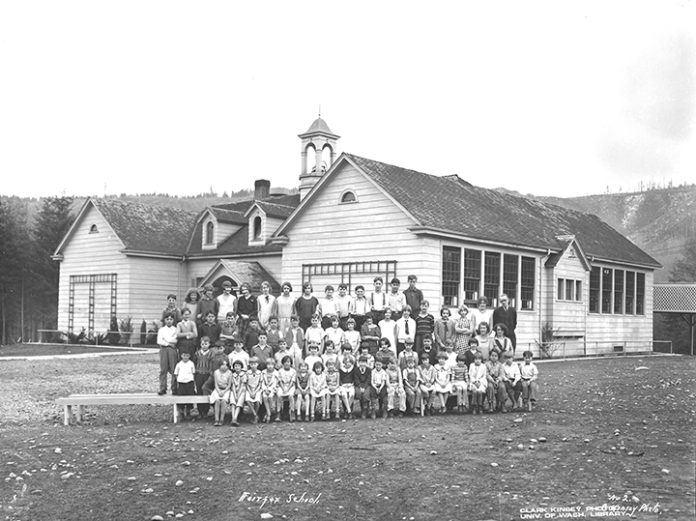Last week’s photo of the Fairfax Bridge over the Carbon told the story of the 1921 road project which finally connected the coal mining towns of Fairfax and Montezuma, and mill town of Manley Moore with the rest of east Pierce County. That year also featured events which led to the region’s eventual demise. This photo #C. Kinsey-1961 of school children assembled in front of the Fairfax School was taken by Clark Kinsey circa 1927 and comes courtesy of the University of Washington Libraries Special Collections.
Though Fairfax was a mine town filled with coke ovens, it was considered by most people the “prettiest town in the entire Carbon River area,” according to Nancy Irene Hall in Carbon River Coal Country. Next to residential areas lined with neat, white homes, the Western American Company constructed a two-room wooden schoolhouse in the late 1890s. Fairfax’s growth continued after Tacoma Smelting Company assumed operations in 1907, and it became the commercial and social center for nearby Montezuma and Manley Moore. By 1915, the school was remodeled to include a gym and heated swimming pool and considered the best facility around. Next to the school was a park with a popular baseball diamond, where locals came from miles around to watch games.
But troubles arrived in 1921 when a miners’ strike hit Fairfax. High coal prices during World War I collapsed at the end of hostilities, so the company sought wage reductions, but workers were unwilling. Fairfax was not alone, as bitter strikes and lockouts ensued in hundreds of coal mining areas throughout the U.S. The Fairfax strike wasn’t settled until 1923, but by then most original miners were gone, never to return. Wilkeson Coal & Coke Company purchased operations in 1925, but their reign lasted less than five years. By 1929, the coke-oven fires burn out and the Fairfax mine was finished. Lumber milling in Manley-Moore soon followed after the stock market crash of 1929.
As for the Fairfax School, there is some mystery as to its ultimate fate. One of the schools in the area burned down in 1934 and was replaced in 1936 and called the Carbon River School. Yet a photo shows the word Fairfax over that front door. In any case by 1939, there were only 24 students and two teachers left and within a few years the children were bussed to Carbonado whose district took over the abandoned school house. As for the Fairfax School, Nancy Hall wrote, “The once beautiful schoolhouse in the town of Fairfax proper, the pride of the area was weather-beaten and forlorn,” and following demolition all that remained was “the crumbling cement shell of the once modern heated swimming pool . . . hidden from site.”







